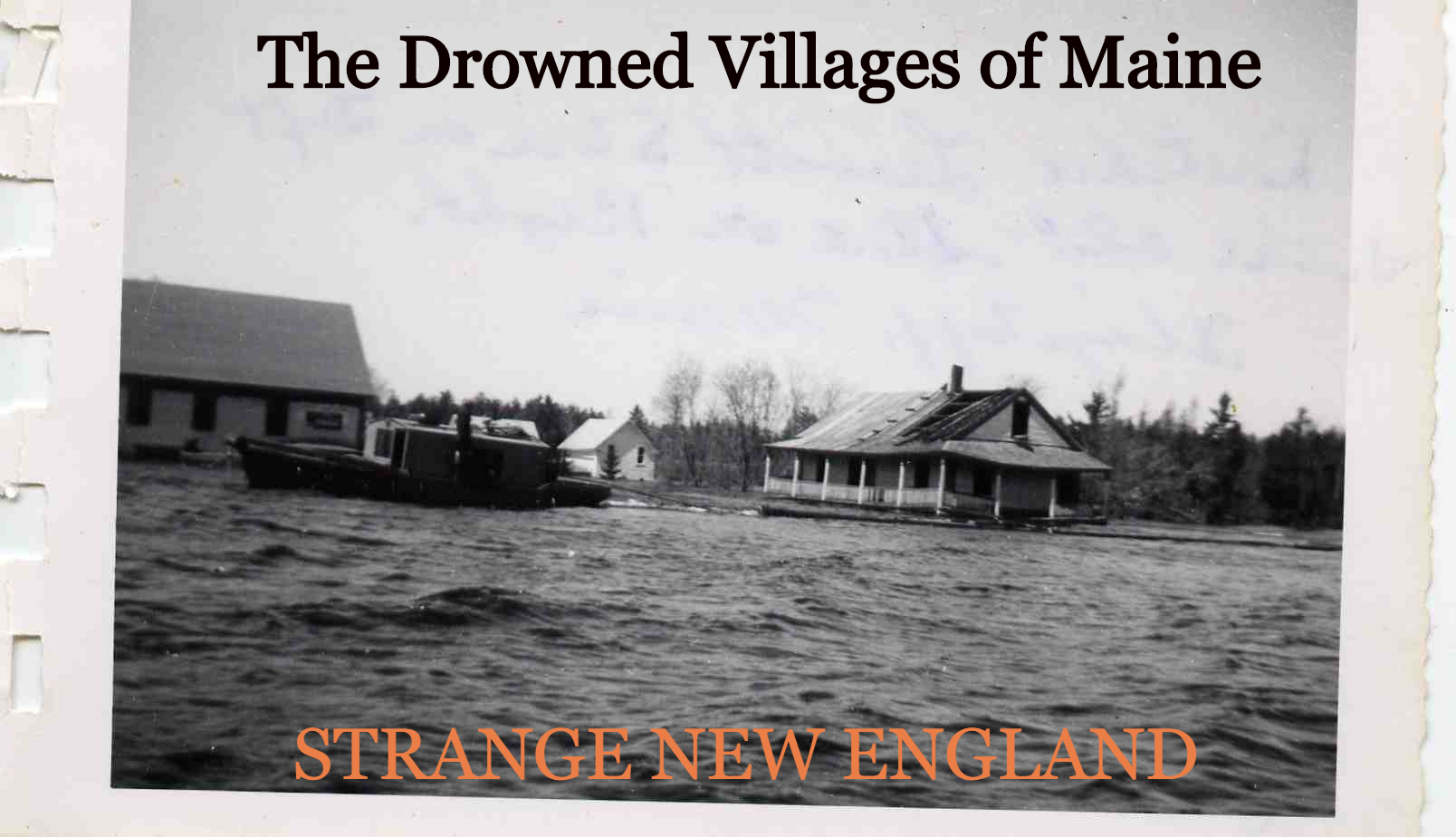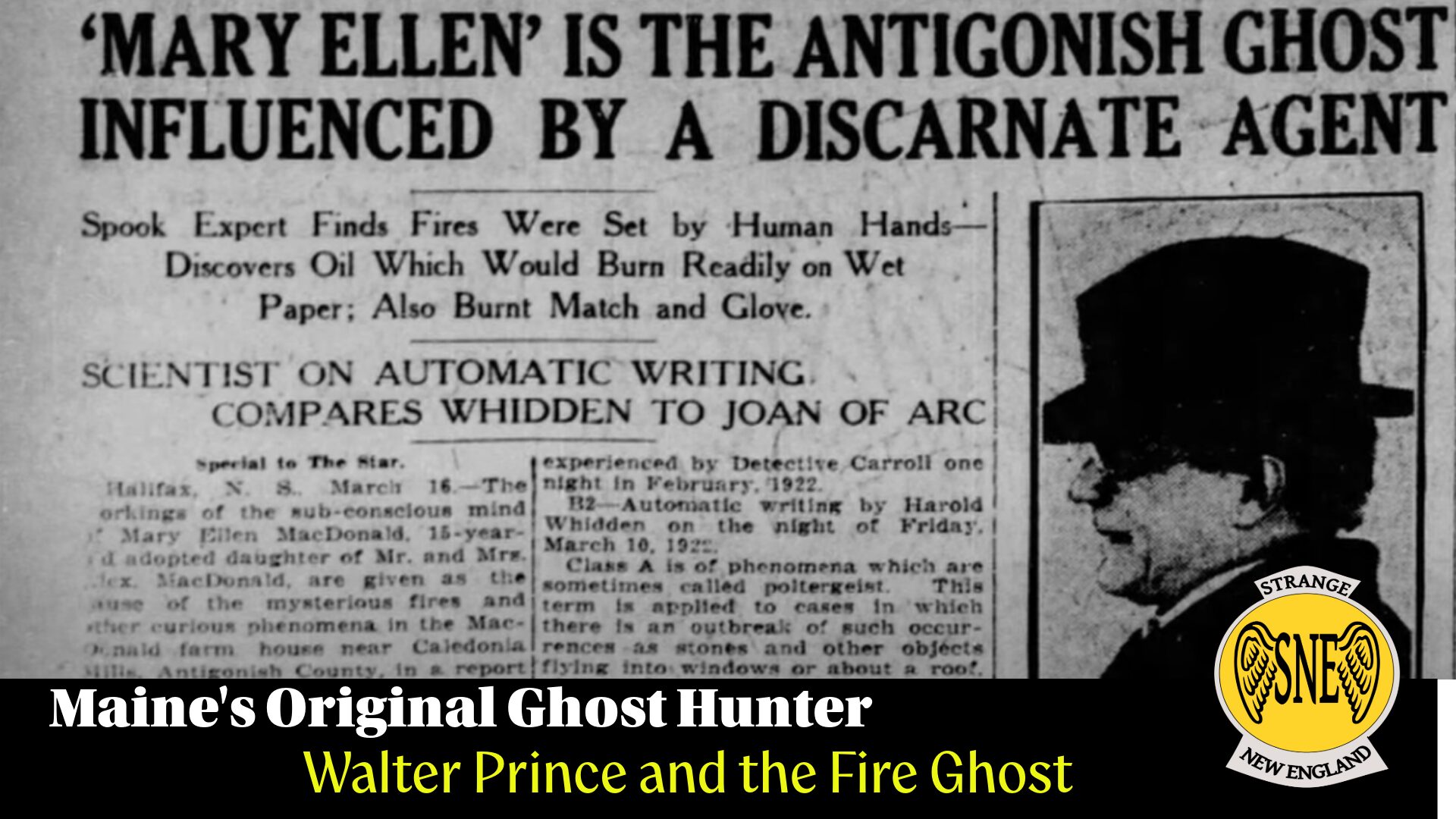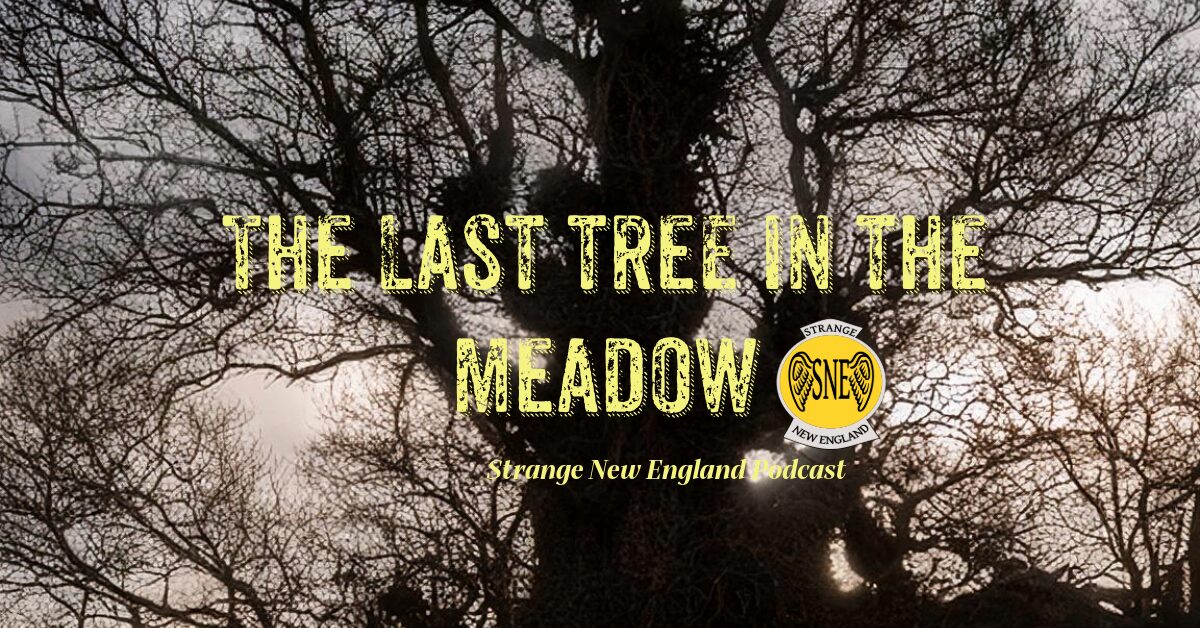
It is dusk of a late summer day and you are standing quietly on a shoreline. There are bits of gnarled tree roots washed ashore here and there, pebbles, and small patches of mossy green vegetation at the lip of the water. The long vista you’re observing is a mixture of green and gold and blue, with the orange-red of the setting sun casting long shadows over the water of the quiet lake. There are trees as far as the eye can see, covering the rolling hills. If you stay very still and listen attentively, you might hear the sound of people laughing at their camps, of an outboard motor slowly cruising along in the rapture of the moment. It is a timeless place, a place of deep beauty. People might work hard and save for years for a moment such as this, far from the crowded city, a place where the angels come to play.
But if you wait a while and let the last light of the setting sun fall away to the West, wait for the stars to turn on one by one in the darkest and brightest night sky you’ve ever seen, if you listen for the long lonesome call of the loon and feel the night air grow colder, you might also hear the sound of people, of cars, of tractors and children laughing, of radios on front porches and dogs barking. You have to hear it with the soul’s ear, but if you listen, the sound is there: for this is a place where memories linger, a place that, if not haunted, is certainly trying to be.
Places are a lot like people. They are born, they slowly grow and take on shape and purpose, they find a way to thrive in the world, and they change, adapt, and continue. But some places, a very few, like people, die. Some simply just cease to be and die a natural death. But some places are murdered. Such is the place you are viewing in your mind’s eye – it is the victim of a premeditated crime, committed for money, leaving the corpse to rot underneath the shallow waters.

Courtesy of the Dead River Historical Society
This is Flagstaff Lake, the fourth largest lake in Maine,a state with over six thousand lakes and ponds. But before the 1950’s, this 20,300 acre lake didn’t exist. Before that, there were the towns of Flagstaff Village and Dead River Plantation, home to families, houses, stores, farms, schools, and churches. Children laughed there, the seasons ran their courses, people fell in love, married, grew old and were buried there. Life was anchored in this place. This was home. Today, it is an extremely shallow man-made lake and below the waters, memories linger. You can almost hear it, if you have an imagination.
People needed power to drive the future. Factories, farms, and businesses all were bursting to grow into something more, to bring jobs and prosperity to even the most far-flung and isloated residents of the land. Electricty was on the minds of everyone who witnessed its possibilities in the few places in America where it was generated. Like so many emerging technologies, it became a revolution, and like many revolutions, there would be casualties.
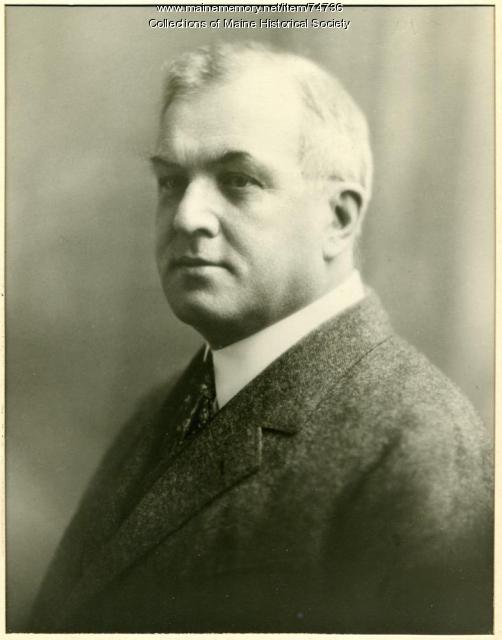
Maine Historical Society Image
The man who set the machinations into motion had profit on his mind. His name was Walter Wyman and the company was the Central Maine Power Company. Wyman was a pioneer in electricty production in Maine. As early as 1899, he and his partner began producing electricty for the town of Oakland. Over time, he set his sights on all of western Maine as a kind of kingdom of power. Wyman looked at the state of Maine’s electrical power production, which was scattered and unorganized. He began to change all of that by purchasing one small electrical producer after another, creating a single power-producing entity, Central Maine Power. Wyman knew that electricty would soon drive the engines of civilization, even in the smallest, most remote areas and he was going to control the means of production. In the early 1930s, he began acquiring other companies, growing his business. In 1936 the federal government instituted the Rural Electrification Act and provided money to those people and companies who could bring electricity to the isolated rural areas of the country. Wyman wanted his share of that money. He wanted to become Maine’s premier electricity producer. Ultimately, he would need to harness hydro-power and the flow of the mighty Kennebec River. He looked at the map of Western Maine and saw an existing lake, a much smaller body of water called Flagstaff Pond. With the area’s vast woodlands and rivers leading to the larger rivers, it was no stretch of the imagination to see a hydro-electric dam that regulated the water flow of the North and South Dead Rivers into the larger Kennebec. Wyman embraced the idea and began by purchasing parcel after parcel of land and burning the forests to the ground. His plan was to create a vast resevoir of water, the future Flagstaff Lake, to drive the turbines and create one of the largest electrical companies in the northeast.
But Wyman had a problem. In 1909, in an effort to preserve Maine’s natural heritage and keep it wild and open, the legislature passed the Fernald Bill. It prohibited companies that produced electricity in the state from selling it outside of the state, banning its export.That was a problem for Wyman who had plans. The law was almost repealed, but the voters of the state chose to keep it. Frustrated, he didn’t let the Fernald Law stop him from building the capacity for power generation in the state, even while building the largest hydroelectric dam in the northeast, the Wyman Dam at Bingham. He had too much power – literally – to sell in Maine. If there was no one to buy his power, that meant that Wyman had to create places that needed it, so he heavily invested in Bath Iron Works, Keyes Fiber in Waterville, shoe companies, and textile mills. He even created the Maine Seaboard Paper Company in Bucksport – a mill that had no way of producing its own power. If he couldn’t export power, he would invest in businesses that needed his power right in the state and profit from selling his power and from their products, which could be exported legally. Wyman was, after all, a business man with plans. And if a business stops growing, it begins to die.
But what of the towns of Flagstaff, Bigelow, and Dead River Planation? The people knew what he was doing. They saw the smoke from the fires, talked to the people who sold off their land to the speculators, understood that change was on the horizon and it was coming to take something away. Central Maine Power sent letters, went door to door,applied legal pressure where it was needed to get things moving and soon people began to succumb to the idea that their town was going to be taken from them. First, it was a farm here,a home there, but then businesses sold out, and larger and larger pieces of land were owned by the company. The townships were dissolved. Most folks took the money and moved away to places like Eustis. Some even had their homes transported like mobile homes. They dug up the dead and put them somewhere else. Some few people held on and refused to take the power company’s checks for their homes. Many of those people simply lost everything, because with their permission or without it, Walter Wyman and his company would have their way, as they always did.
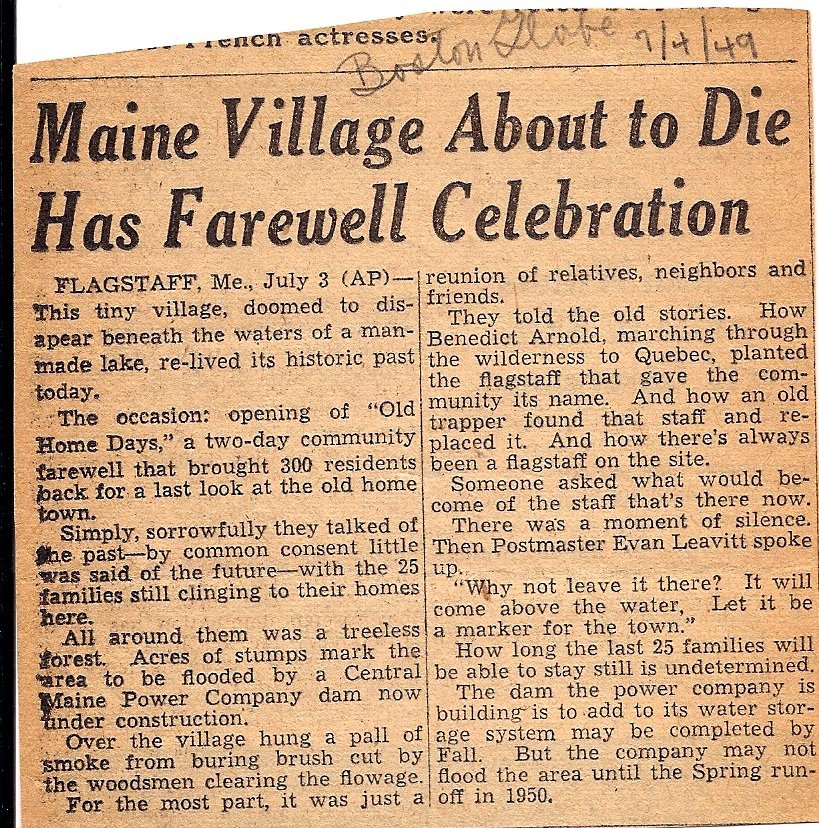
Courtesy Dead River Historical Society
In July of 1949, about 300 people met in the village one final time before it all was taken from them. As they met, they were surrounded by a an empty forest of tree stumpage, all cut and removed so that the reservoir for the nearly completed Long Falls Dam could be free of debris, as it created the largest man-made lake in the state of Maine. They must have been quiet; their past was being taken from them, even if they had cashed Wyman’s checks. The outskirts were already empty,the buildings all future ghosts just waiting for the inevitable. The school had already been razed to the ground. The church would be flooded, as would all of the other houses, under water and lost to their sight. There was nothing to celebrate. It was like gathering together for a kind of execution. Within a year, everything would be gone.
In 1950, the Long Falls Dam was completed and the last people in the villages and towns witnessed the rising waters. It was a slow death, they say, as it took weeks for the waters to fill the 20,000 acres. All those places they knew so well, the houses that sheltered them, the fields that fed them, the lawns where the children played, even the graveyard that honored their revered dead, all were erased from human sight for the march of progress. In order for Walter Wyman to provide the power that would eventually be exported from Maine to Boston and places south, this quiet, rural place would need to go, and with it, the heritage of hundreds of ordinary people without the money that bought influence. The Fernald Bill would be repealed, people would move on and these places, now underwater, would eventually be forgotten until finally, only a few survivors who grew up there, can recall the streets, the lights in the corner store at twilight, the sound of the radio and people rocking on their porches on a hot summmer night.
They say that Benedict Arnold, on his march to Canada, stopped at this place and put up a flag. When he left, the flagstaff remained, replaced by a trapper who found it. From that moment on, there had always been a flagstaff in the town. It was its namesake. In the end, when they flooded the town, they let it stand and for awhile, it poked above the waters as a maker, a kind of gravestone, for the town whose life was taken from its people and its people taken from it. If you go onto the lake today and stand on the shore, search as you will, you will not find that flagstaff. But if you take a moment, especially at dusk or in the early morning and stare for awhile over the calm waters, you just might discern the outline of a barn roof,of a stand of trees, or even a church steeple. Stories are all that are left and when the last resident of these places passes away and is buried in some other town’s cemetery, then legends will begin to grow. The story of a murder – something ostensibly done for the good of the many – that cries out, the drowned village that whispers from under the waters – remember me…

REFERENCES
Dead River Historical Society
https://sites.google.com/site/deadriverareahistory/home/the-flooding-of-flagstaff
“Walter Wyman and River Power Power”
https://www.mainememory.net/sitebuilder/site/815/page/1225/display
MUSIC CREDITS
“Collapse” by Myuu (Creative Commons)
“Edge of Life” by Myuu (Creative Commons)
“Strange New England Theme” by Jim Burby
PHOTO CREDITS
Maine Historical Society
Picture of Flagstaff Lake – by Mlanni98 – Own work, CC BY-SA 4.0 https://commons.wikimedia.org/w/index.php?curid=77135333
